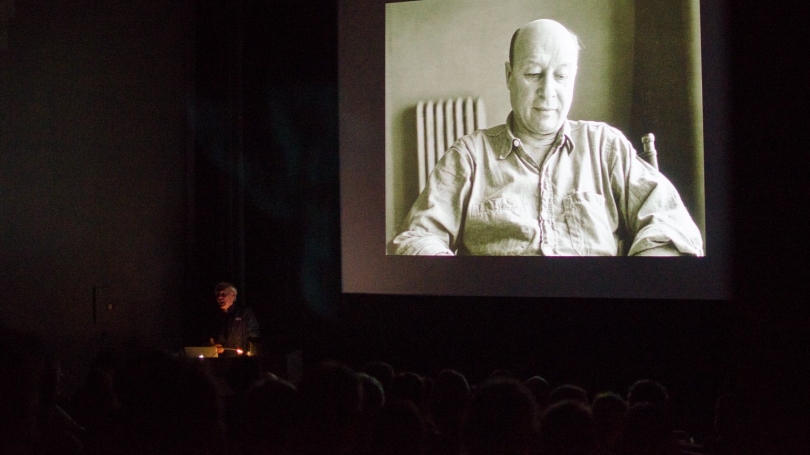
- Undergraduate
- Disciplines
- Artists-in-Residence
- Exhibitions
- Internships
- News & Events
- People
Back to Top Nav
Back to Top Nav
Back to Top Nav
Back to Top Nav
Back to Top Nav
Back to Top Nav
Back to Top Nav
Few people have heard of — yet alone seen — water treatment pollution caused by paper mills. Even fewer have seen such damage from the sky and called it art. Yet for world-renowned photographer and current Montgomery Fellow Emmet Gowin, a certain fascination and peculiar sense of beauty comes in the circular blossoms of tropical hues that explode from the seemingly serene water.
Gowin captured the image in “Aeration Pond, Toxic Water Treatment Facility, Pine Bluff, Arkansas” (1989), one of many photographs the artist presented in his Montgomery Lecture on Tuesday. The world-renowned photographer spoke about the progression of his life and career through personal pictures, which dated back to his own undergraduate years at the Richmond Professional Institute (now called Virginia Commonwealth University), before crowds packed into the Hood Museum auditorium.
Gowin, who was born and raised in Virginia, said he discovered an early love for the arts while studying business in college. He quickly immersed himself in photography after meeting his wife and muse Edith, and has since established a name for himself through captivating images that use various aspects of form, light and scale.
“His work and his teaching over the course of his career have helped to elevate photography from a really technical craft to a view as a real art form,” Montgomery Fellow program assistant Christianne Hardy Wohlforth said. “You can see that in his work he has a real breadth in the kinds of things he’s photographed over his lifetime. There’s a common theme of intimacy in everything that he does.”
His photographs range from minimalist portraits to elaborate aerial landscapes, and have garnered numerous accolades that earned him recognition as a recipient of the Guggenheim and Pew fellowships as well as permanent collections in international art museums.
But Gowin said his pictures are not taken with the intention of receiving critical acclaim. Rather, he seeks to respond to perplexing visual contexts that he feels need to be captured.
“Over time, I’ve realized that if you see something visually appealing and you don’t take a picture of it, you’re going to feel bad for the rest of your life,” he said.
In Tuesday’s presentation, attended by studio art professors, students and local residents, Gowin included negatives of some of his images in addition to final works.
Brooke Bonsack ’16 said that she appreciated the variety of subject matter presented in the photographs, which included atomic bomb fields, Gowin’s family and rainforests.
“As a student in a drawing class, it was interesting to observe the way he used light and try to figure out how I would draw some of his images,” Bonsack said.
For studio art lecturer Brian Miller, listening to and speaking with Gowin was a chance to reunite with the mentor who first inspired him to teach. Miller was invited to speak at Princeton University while Gowin taught there.
“To Emmet, photography is more than just doing the action,” Miller said. “It’s about how he lives his life — what he does in the morning, how he shops for groceries, what he eats, what he reads. He treats art-making as something beyond a profession. It’s something that’s a part of him.”
The chronological presentation of Gowin’s life featured intimate portraits of his wife and family that are a part of a traveling exhibit currently on display in Bogotá, as well as recent pictures that reflect his current fascination with insects. One image he shared, “Edith in Panama: Leaf Mask” (2004), superimposed Edith’s composed, demure face on a decaying leaf juxtaposed with various beetles and cockroaches.
Over time, Gowin said, his decisions for what subject matter to photograph became unconscious, but his passion for the art remained constant.
“I really have so much faith in these pictures,” Gowin said. “I know that when I’m gone these pictures will still be fine. They won’t need me to give an explanation or a background. There is a rhythmic beauty and truthfulness in them that people will absorb or they won’t absorb. The pictures have what they have and that’s all that they will ever have.”
Gowin has published several books that showcase his notable works and fascination with the world around him. His current project is a book that will feature approximately 1,200 original photographs of tropical insects that he hopes will be appealing to students, scientists and artists, he said.
“There are so many insects in the world, and I hope to travel to the tropics again soon and visit the places that Alfred Wallace visited,” Gowin said. “I want to get my collection of images up to 2,500 unique insects.”
Gowin and his wife will reside at the Montgomery House until Oct. 18, and Gowin will meet with various photography classes as part of his residency.
Gowin’s work is on display at the Hood’s Albright Gallery.